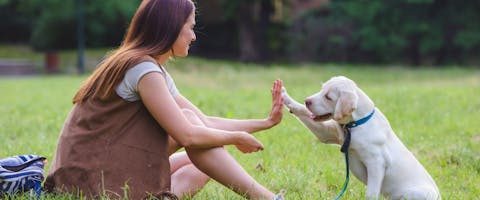Updated 18th July 2025
Welcoming a dog into your life soon, and want to get clued-up on how to train a puppy? Look no further as below, you’ll find a puppy training schedule by age, along with tips for leash training, socialization, potty training, crate training, command training, hand signals and more.
Along with teaching your dog to behave, puppy training allows for essential bonding, helps your dog to gain trust, and begin the foundations for a strong relationship together. So without any further ado, let’s start with a suggested dog training plan set around your puppy’s developmental milestones.
Puppy training schedule by age
If you want to get started with your dog’s training plan right away, below find a training schedule with handy time stamps based on your dog’s age. Roughly follow along, but take it at your puppy’s pace and consult your vet or a dog trainer if you have any concerns.
Puppy training at eight to twelve weeks
The first stage of your dog’s training plan should be getting your puppy used to their surroundings and to begin potty training. Lessons they should learn in this time are as follows:
- Being comfortable with a collar and leash.
- Getting used to yours and the vet’s touch, even in sensitive areas.
- Letting you take things out of their mouth when necessary.
- Getting used to traffic noises, car rides and other common situations.
- Socialization with other fully-vaccinated dogs.
- Start with potty training – this is ongoing, though, and can take your puppy several months to master.
- Crate training - it’s essential that your dog gets used to alone time and to self soothe.
Trusted tip: If you’re adopting a dog and can’t start training right when they turn eight weeks, don’t worry! Your dog can still learn all the important tricks and commands a little later.
Puppy training at three to six months
The second training stage should include impulse control, which includes your puppy learning their first actual commands, like ‘sit’, ‘down’ or ‘stay’.
While you’ll first focus on making them learn the commands themselves, you will then teach them to remain as they are for increasingly longer periods, up to a point where they won’t get up, lie down or move away unless you give them the proper release command.
As we mentioned earlier, you will need to continue with potty training your dog at this stage, or until they’ve mastered it.
Puppy training after the first six months
The third training stage starts at approximately six months and includes reinforcing all previously learned skills, mastering potty training and learning further commands or tricks.
This is also the stage where your puppy will learn to be alone for longer periods of time, and how to be gentle during play with you and other dogs.
Your puppy will also learn how to be ‘polite’ – meaning they will learn that barking or nipping at you won’t get them anywhere.
This is also the earliest stage that you can start with special courses such as agility or parkours training.
Trending posts
Purr-use some of the top blogs our members have been loving this month- Top male dog names for your new furry friendGot a new furry family member in your pack? Check…
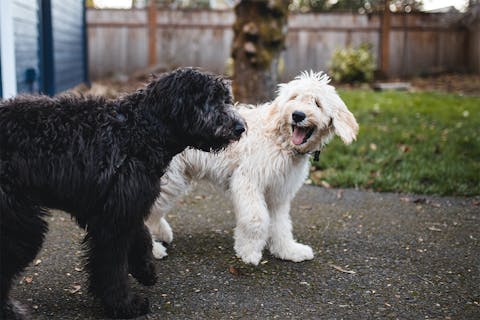
- Top female dog names for your new fluffy palWelcoming a new pooch into your family? Explore…
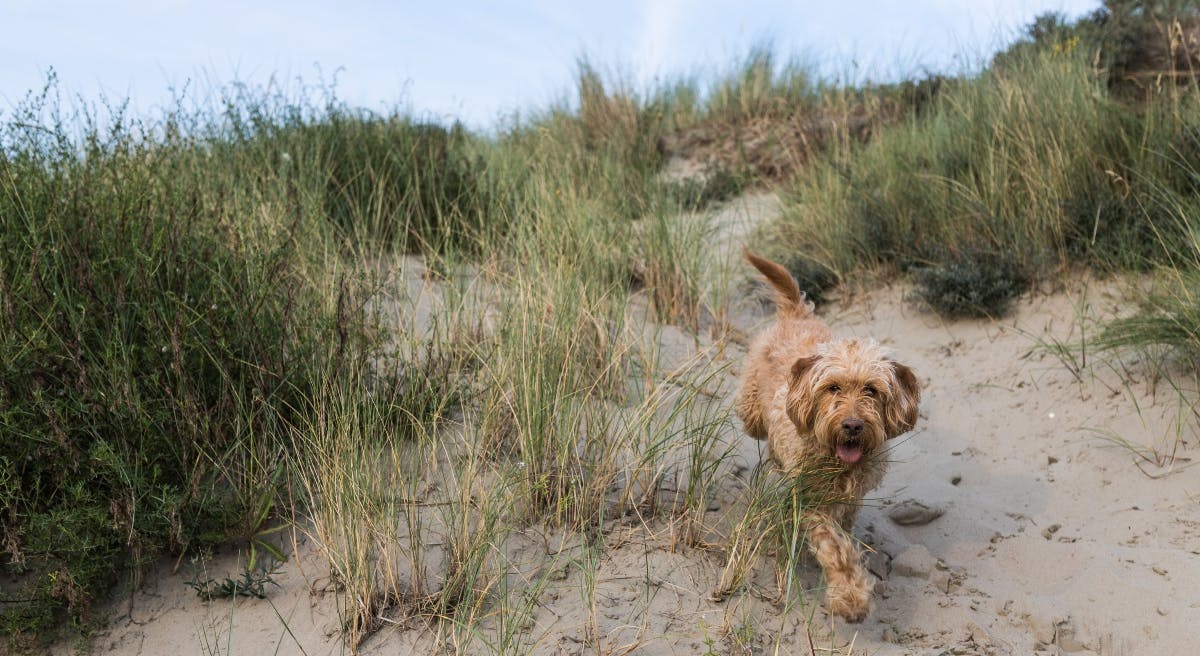
- 250+ gray cat names your silver feline will loveRecently welcomed a fluffy gray bundle of joy into…

- What are normal pet sitting rates?Discover the average pet sitting rates for animals…
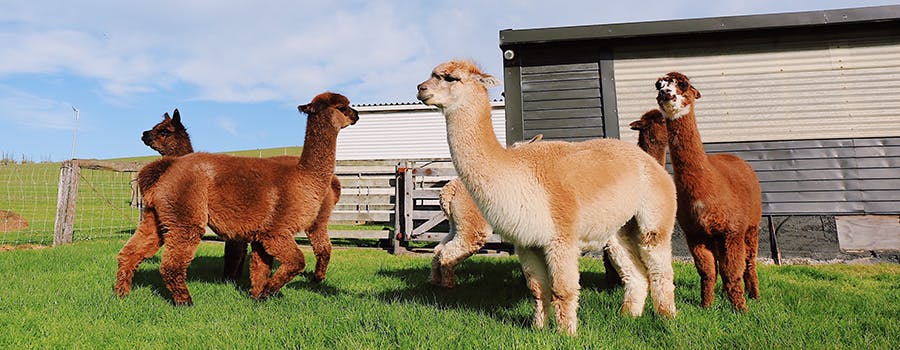
- Unique dog names to stand out from the packDare to be different with our list of the best…
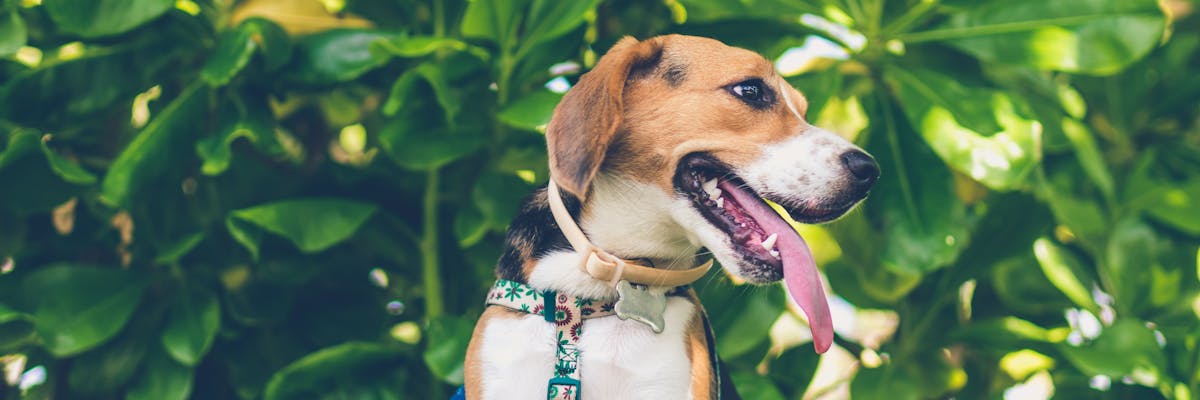
When to start training a puppy
Getting started with a puppy's training can happen on their very first day in their new home. Puppy training for beginners might be a little daunting for you as a new pet parent, but the sooner you begin, the better.
Puppies learn at different stages of their lives, but they can begin to learn basic commands like ‘sit’ and ‘stay’ as early as 8 weeks old. We’ll go more into basic puppy training commands further below (including the dreaded potty training puppy stage).
Between 8-12 weeks is also a great time to begin socialising your puppy with other fully vaccinated dogs, and to begin leaving them alone for short periods of time to prevent any separation anxiety-related issues further down the line. Crate training a puppy creates a safe space for them to retreat to while you’re out and ensures minimal house destruction while they’re still in the chewing stage.
Leash training a puppy
Taking your puppy outside the house is the next step in your puppy training journey. Taking your new pup out for a stroll can be one of the most exciting things about having a new dog, and getting your dog to walk on a leash is an important part of puppy training.
Choosing the right lead and equipment for your first walk together is a great place to start, and puppies in particular will benefit from a harness for a more comfortable walk.
Location is another important element, and you may find it useful to practice using a leash on your dog a few times in the garden, or somewhere quiet where your puppy is less likely to be distracted. This will help to get them used to the feeling of the harness, as well as walking on a leash.
With a pocket full of treats at the ready, you should aim to keep a loose leash, continuing to walk and praise your dog whenever the leash remains loose - positive reinforcement is key.
Remember, it’s okay if your pup walks a few steps away from you, but the moment the leash gets tight, or if your dog pulls in a different direction away from you, try to encourage them back to you, giving lots of praise when they do. This should train your dog to associate being near you on a walk as a positive thing. For more on this, check out our blog on how to train a dog to walk on a leash.
Crate training your puppy
By crate training your puppy, you give them a calm, safe place to retreat to when they’re tired, nervous or stressed, or during noisy events with unavoidable noise, such as fireworks. Start by bringing them to their crate for 10-minute intervals while they’re nice and calm, so that they associate the crate with relaxation. As we said before, positive reinforcement is key for encouraging good behavior, so reward them when they go in with their favorite treat or toy.
Potty training a puppy
Consistency is key when it comes to potty training your puppy. Maintain a schedule by letting them out first thing in the morning after eating, and post playtime throughout the day. At this point they should start having enough bladder control to learn to hold it. Reward your puppy with a treat every time they successfully poop or pee outside.
Socializing your puppy
Socialization is an important part of puppy training. Getting them used to other people and other dogs makes our pups more friendly and well-behaved, and less prone to fear-based aggression.
Once your new puppy has been fully vaccinated, you can start taking them out in public and allowing them to socialize. Letting your puppy meet and play with other dogs in a neutral area, such as a dog park, is a great place to start as well as taking them to meet friends and family dogs to introduce them to as many waggy tails as possible.
Puppy classes are another great way to socialize your pup. As well as helping to boost their confidence and make new pup pals, it can be a great place to put into practice those basic puppy training commands.
And it’s important to remember that socializing your puppy goes beyond just introducing them to new people and pets. It’s about desensitizing your dog to everyday situations they’ll encounter. Getting your dog used to noisy traffic, bikes and daily life out in the world will help them to grow into a calm, fear-free adult dog.
How do you train your puppy to sit?
Teaching your puppy simple commands can be a lot of fun for you and your pooch. Here are some things to keep in mind during puppy obedience training:
- Always use the same word to make them sit. Most people use ‘sit’, but it doesn’t have to be that. If ‘sit’ sounds very similar to a family member’s or friend’s name, for example, you could also use ‘bottom’ or even a completely made-up word – just make sure you’re consistent.
- Try to use hand signals, too. If you teach your puppy to listen to words and hand signals, your puppy will be able to follow your commands as long as they can either hear or see you. This does not only come in handy in loud environments, but also should your dog develop hearing or sight issues later in life.
- Choose a quiet place to train. Help your puppy concentrate, distraction-free in a quiet room with no one else around, especially in the early stages of command training.
Simple steps for teaching your puppy to sit:
- First, try to get their attention by calling their name or holding up a toy or treat. Position yourself sitting across from them.
- Try to get them to sit down by themselves by stroking their head or even gently tapping or pushing down on their behind, while constantly, calmly saying ‘sit’ and holding up your free hand in the gesture that also means ‘sit’ (often that’s your index pointing up with the rest of the hand in a fist).
- Praise your dog as soon as they're in a sitting position, and give them the treat.
Over time, your puppy will learn to associate the word and signal with the gesture. Once your puppy has that down, you can continue by using release words to let them know when they can get up again, and making them sit for increasingly longer periods.
Basic commands to teach a puppy
Whether you want your puppy to sit, stay, come, or play, learning basic commands is not only a great way for your new companion to begin their puppy training, but these are key commands that you’ll use throughout your puppy’s life.
Similar to leash training, basic commands, such as ‘sit’, ‘lie down’ and ‘stay’, can be easily achieved with patience and some positive reinforcement.
Dog training tips for puppies: dos and don'ts
We already know that patience, positive reinforcement and consistency are key when it comes to puppy training. But for a handy list of the do’s and the don’ts of puppy training, look no further.
Do…
- Train in short sessions: 10 to 15 minutes per session should be more than enough, and will avoid overexerting your puppy.
- Stick to teaching one command at a time to avoid confusion, only moving onto the next command when they’ve mastered one.
- Say your commands clearly and consistently, and be aware that repeating command words during puppy training won’t necessarily improve results, and you could risk your puppy getting confused or bored.
- Choose a time and location for puppy training where you’ll have no distractions. It can also help to switch up locations to introduce them to new sights and sounds.
- Be patient, kind and considerate – remember, it’s hard work being a pup!
Don’t…
- Force your pup to train – it’s better to come back to it when they’re more engaged and more likely to be in the mood for training.
- Get frustrated – remember, positivity and patience is key with puppy training.
- Let your puppy get bored – keep training fun and engaging. If you notice your puppy becoming bored, it’s best to switch activities or come back to it later.
- Use negative reinforcement – it will only make your puppy nervous or frightened, and may lead to aggressive behaviour in the future.
Finding a puppy training class
Puppy training classes are great if you need further support training your puppy, or if you wish to teach your dog more advanced training.
The help and support of a dog trainer can be very useful, particularly for new dog parents. Taking advantage of a trained expert allows you to ask all the questions regarding crate training a puppy, as well as getting all the puppy potty training advice, and any general puppy training questions. And, as an added bonus, your pup will get to socialise with lots of new pals in the class.
Looking for a local puppy training class? You can start by asking around at your local vets, or by looking online. Make sure to only book in with a registered and reputable dog trainer – you can search online using the Kennel Club website to find a puppy training class near you. Most will be happy to meet you beforehand, or let you sit in on a class, so you can make sure it’s right for you, and your pooch.
Unwanted puppy behaviours to keep an eye on
Some behaviors puppies show aren’t so much bad behaviours - they’re natural, and haven’t been trained out of them to fit into life with a human. One good example for this is your puppy peeing inside or chewing on your shoes.
Other behaviours, like biting or destroying your furniture, could be caused by stress or boredom, in which case you should try and make your puppy feel safe and keep them engaged. All dogs, but especially young ones, need attention and a lot of playtime to be happy.
If you spend lots of time with your new four-legged friend, feed them enough good food and treat them with love and kindness, but the little guy or gal still shows signs of anxiety, it’s time to consult with your vet and maybe also employ the help of special trainers.
Useful resources
- 10 dog training hand signals & vet-approved tips for mastery
- Training a rescue dog: settling in & house training
- How to toilet train a puppy: a guide to puppy potty training
- Everything you need to know about Jack Russell Terrier puppies
- Everything you need to know about Corgi puppies
- Everything you need to know about Chow Chow puppies
- Dog recall training: how to train a dog to come when called
- How to leash train a dog: 11 tips on canine leash training
- How to bond with your dog: 12 vet-approved ideas
- 14 reasons dogs are the best pets: benefits of having a dog

